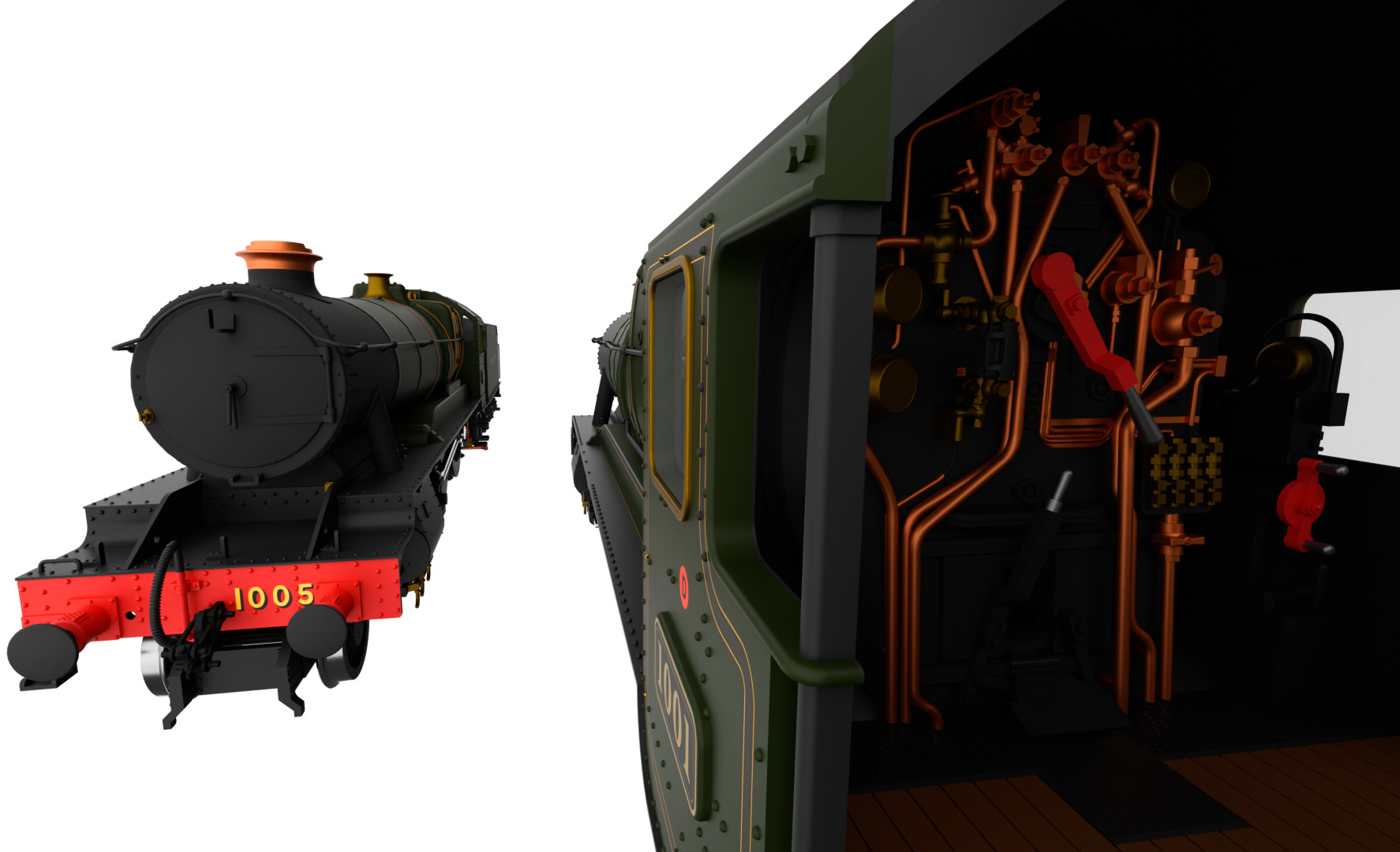All-new GWR 'County' for 'OO' from Rapido Trains!
Rapido Trains UK is producing models of the GWR 'County' 4-6-0 for 'OO'.
· 10 different versions are available to pre-order, here
· Highly detailed die-cast metal and injection-moulded construction
· Many separately-fitted era-specific details
· Firebox flicker with dynamic fire draw effect
· Factory-fitted speakers
· Smooth-running mechanism
· Fitted with MoPower stay-alive, tender pickups and a 21-pin decoder socket
· NEM coupler pockets
OO Gauge GWR County 4-6-0
As World War II raged on, the Great Western Railway realised there was a growing need to expand its fleet of locos.
In the usual Great Western tradition, Hawksworth developed the design from the existing family of mixed traffic locomotives descended from the 4-6-0 'Saint'. However, so it could compete with the powerful three-cylinder locomotives of the LNER and LMS this new design needed to be modernised. It also needed to be easy to service and repair, as the railway had lost many of its shed staff and labourers to wartime austerity.
Hawksworth’s new design was designated the 1000 Class, more commonly known as the 'County'. It would be the last of the 4-6-0s built by the GWR.

Hawksworth drew inspiration from further afield, adding distinctly LMS and LNER features. These included a joined single splasher rather than one over each wheel, and a tall flat-sided tender. When combined with features previously implemented on the Modified 'Hall' Class, it resulted in a thoroughly modernised GWR locomotive design. The 'County' followed the Modified 'Hall' in its use of plate frames and separate cylinder castings, while the crew’s life was made easier by the installation of a hopper ashpan.
The most identifiable feature is the GWR No. 15 boiler, which was pitched higher than anything previously built by the GWR.
This new type of boiler was very similar to that of the Stanier 8F, and this is no coincidence - Swindon Works built 80 8Fs from 1943 through to ‘45. The No. 15 boiler was pressed to 280 PSI working pressure, dwarfing the 225 PSI of the 'Castle' Class and generating a far greater tractive effort. On paper, this made it the most powerful 2-6-0 cylinder locomotive produced by the GWR and theoretically, it should have matched the 'Castles'' performance.
Between 1945 and 1947, the GWR built 30 'County' Class locos at Swindon Works. They were later named after English or Welsh Counties, omitting the Shire part of their name as traditionally Shire and County mean the same thing. Emblazoned on a long straight nameplate, even this distinctive feature was considered non-standard, as traditionally the GWR used a curved plate fixed to the outside of the splasher.

Working as a true mixed-traffic locomotive the 'County’s' mainline duties included express trains such as the Cornishman and the Cheltenham Spa Express, as well as milk and fast freight work.
Achieving a top speed of 99 mph on test, the 'County' sadly underperformed. This wasn’t helped by the poor quality of coal available at the time. Though the GWR denied reports of rough riding, there are tales of locomotive crews being cautious about taking the locomotives over 70mph due to the rough ride. In the beginning, their claimed high performance caused them to be rostered for ‘Castle’ duties, which they struggled to maintain.
Working under such high pressure caused problems too, and under BR ownership in the mid-to-late 1950s, the working pressure was lowered. BR also used this as an opportunity to improve draughting, fitting them with a double chimney. With the boiler now topped off at 250 PSI its overall tractive effort also dwindled.
Although all 30 of the Counties were inherited by BR, the entire Class was withdrawn between 1962 and ’64 in-line with the rundown of steam on the Western Region and the rise of diesel-hydraulics.
The last working example was No. 1011 County of Chester, which completed the County Fairwell railtour between Birmingham and Swindon in September, 1964. Sadly, none survived into preservation.
Despite the unfortunate fate of County Class, significant efforts are being made to bring them back into the public eye. The Great Western Society has 1014 The GWR County Project, a bold initiative to bring an ‘authentic as possible’ rendition of the class back to life, utilising the frames of a Modified Hall and a Stanier 8F boiler. With an impressive amount of work completed, No. 1014 County of Glamorgan is well on the way to joining Western counterparts as a working member of Didcot’s fleet.
The Rapido Trains UK highly-detailed OO Gauge rendition of the GWR County will be available in a variety of liveries, including County of Chester in railtour condition. With the Great Western Society’s County Project progressing nicely, a model of No. 1014 County of Glamorgan is included in the range.
Detail variations include representations of locomotives from their short-lived time in GWR ownership and their later BR working life. This includes single and double chimneys, speedo drives, smokebox number plates, buffers, oil pipes, running board pipes, and nameplates.
For modellers who prefer etched brass nameplates, a painted plate appropriate to the relevant version is included in the detail bag.
A smooth-running mechanism, factory-installed speakers, NEM coupler pockets, an ESU 21-pin decoder socket, MoPower stay-alive capacitor, tender pickups, vacuum cylinder between the frames, and firebox flicker with a dynamic fire draw effect is promised.
The project is at the tooling stage, with models available to pre-order here.


